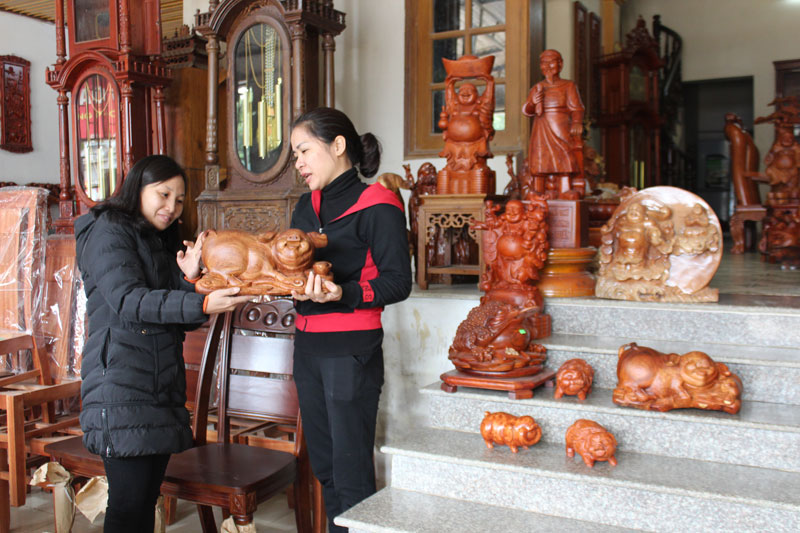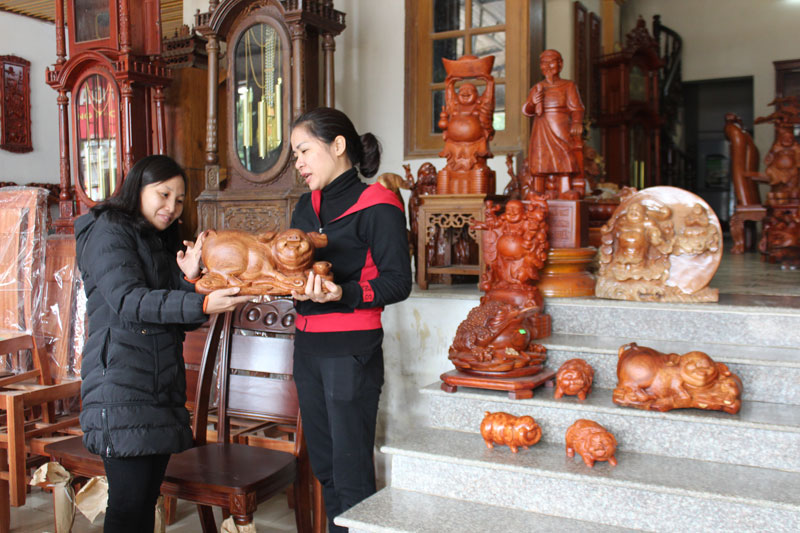
(HBO) – Feng shui pigs in Hoa Binh city are attracting a large number of customers thanks to diverse designs and materials, and reasonable prices.
Many families seek to buy feng shui
pigs to decorate home with a wish for a New Year of peace and prosperity.
High-class
and more meaningful in terms of feng shui are pigs that are made of wood,
resin, gem, natural stone, copper, stone powder, and artificial gem.
Nguyen Thi Huyen, owner of a furniture shop in Phuong Lam ward, Hoa Binh city,
said this year, feng shui wood pigs were particularly favoured by customers.
"Within one month before Tet, I sold nearly 50 feng shui wood pigs,” she said,
adding that most people choose the size of 38cm (length), 15cm (depth), and
20cm (height) because they are "prosperous and lucky” numbers.
It is possible to display feng shui pigs according to the themes "Phat – Tai”
(prosperity) or "Mau tu” (mother and child) or "Heo vang” (golden pig).
Each feng shui pig is sold for between 700,000 VND and 3.5 million VND. The
products are made from Dong Ky wood trade village in Bac Ninh province,
ensuring quality, sophistication, and eye-catching design.
Apart from decorating home, feng shui pigs could be used as a meaningful Tet
gift.
Nguyen Van Hung from Phuong Lam ward, Hoa Binh city said the pigs are round and
well-shaped, symbolising the well-being and abundant fortune. The placing of a
feng shui pig at home is believed to bring prosperity and happiness to families,
he said.
In the five basic elements, pig belongs to the female nature, which is suitable
to present as a gift on the occasion of housewarming, shop launching, business
opening, or longevity celebration events.
"Therefore, on the traditional Lunar New Year, I’ve bought some feng shui pigs
made of stone powder and artificial gem to present my friends and business
partners with a hope that they will have a care-free life,” Hung said./.
With an increasingly vibrant and widespread emulation movement aimed at building cultured residential areas and cultured families, Yen Thuy District has been making steady progress toward improving both the material and spiritual well-being of its people, while fostering a civilized, prosperous, beautiful, and progressive community.
Once lacking recreational spaces and community facilities, Residential Group 2 in Quynh Lam Ward (Hoa Binh City) has recently received attention for the construction of a new, spacious, and fully equipped cultural house. The project followed the model of state support combined with public contributions in both labor and funding.
The "All people unite to build cultural life" movement, which has been effectively integrated with Kim Boi district’s socio-economic development goals, is fostering a lively spirit of emulation across local residential areas, hamlets, villages, public agencies, and enterprises. In addition, through the initiative, traditional cultural values are being preserved and promoted, while community solidarity and mutual support in poverty reduction and economic development are being strengthened.
A working delegation of the Hoa Binh provincial People’s Committee led by its Permanent Vice Chairman Nguyen Van Toan on June 11 inspected the progress of a project to build the Mo Muong Cultural Heritage Conservation Space linked to tourism services in Hop Phong commune, Cao Phong district.
Born and growing in the heroic land of Muong Dong, Dinh Thi Kieu Dung, a resident in Bo town of Kim Boi district, in her childhood was nurtured by the sweet lullabies of her grandmother and mother. These melodies deeply imprinted on her soul, becoming an inseparable part of her love for her ethnic group's culture. For over 20 years, this love for her hometown has driven Dung to research, collect, and pass down the cultural values of the Muong people to future generations.
In the final days of May, the Ethnic Art Troupe of Hoa Binh Province organized performances to serve the people in remote, mountainous, and particularly disadvantaged areas within the province. These were not just ordinary artistic shows, but they were the meaningful journeys aimed at spreading cultural values, enhancing the spiritual life of the people and contributing to the preservation of ethnic minority cultural identities.



